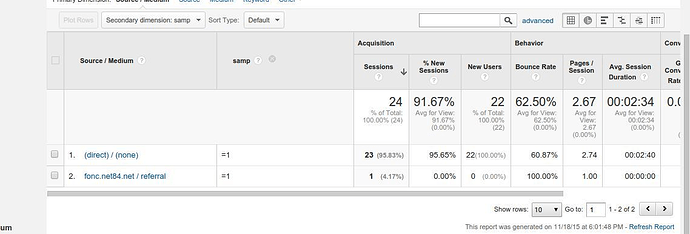A Comprehensive Overview to 'Secondary Dimensions' in Google Analytics: Insights Revealed
A Comprehensive Overview to 'Secondary Dimensions' in Google Analytics: Insights Revealed
Blog Article
Navigating the Depths of Additional Measurement in Google Analytics: A Comprehensive Exploration on Its Functionality
Additional measurements, though apparently uncomplicated at initial glance, harbor a riches of untapped possible waiting to be harnessed. As we get started on this journey to check out the nuanced capability of secondary measurements, we will discover how this attribute can illuminate patterns, introduce relationships, and inevitably lead the method for notified decision-making in the digital landscape (what is a “secondary dimension” in google analytics?).
Understanding Second Dimensions in Google Analytics

Comprehending just how additional dimensions job is crucial for leveraging the complete power of Google Analytics. These dimensions help you answer extra complex questions about customer habits and the performance of your website web content and marketing initiatives. For example, you can make use of additional measurements to examine which internet browsers or tools are most generally used by site visitors who purchase, or to contrast the bounce prices of different web traffic resources. By incorporating main metrics with additional measurements, you can gain useful insights that drive notified decision-making and optimization methods - what is a “secondary dimension” in google analytics?.
Leveraging Secondary Measurements for Data Evaluation
Building upon the foundational understanding of exactly how secondary measurements improve data evaluation in Google Analytics, the utilization of these extra layers of information becomes vital in extracting beneficial insights for educated decision-making and optimization techniques. By leveraging secondary measurements, experts can delve deeper into the performance metrics by adding more context to the primary measurements, therefore revealing concealed patterns and relationships that may not be obvious initially glance. This deeper degree of analysis enables businesses to much better understand individual actions, determine trends, and identify locations for enhancement.
In addition, secondary dimensions offer an even more comprehensive sight of the data, permitting division based upon numerous specifications such as demographics, gadgets, web traffic sources, and extra. This division promotes an extra granular analysis, allowing businesses to customize their techniques and campaigns to certain audience segments for improved targeting and customization. Fundamentally, the strategic use second dimensions encourages companies to make data-driven choices that drive development and success in the digital landscape.
Advanced Methods for Second Measurement Application
Exploring detailed techniques to harness the complete capacity of second measurements in Google Analytics raises the depth and sophistication of information evaluation for tactical decision-making. One innovative strategy for implementing secondary dimensions is using customized measurements. By defining customized dimensions, customers can sector data further to gain more details understandings right into user actions, such as tracking communications with certain aspects on a web page or monitoring the performance of a specific advertising project. Another advanced technique is the application of regex (routine expressions) within secondary measurements. Regex permits for more powerful and adaptable pattern matching, making it possible for individuals to produce complicated filters for data analysis. Furthermore, integrating second dimensions with sophisticated segments that site can offer much more granular understandings by using numerous layers of division to the information. This technique enables for a much deeper understanding of customer habits based on numerous criteria all at once. Applying these advanced strategies for additional measurements in Google Analytics encourages individuals to carry out much more innovative evaluation and make data-driven choices with accuracy.
Interpreting Insights With Second Dimensions
When analyzing insights with second measurements, it is important to consider the context of the information and exactly how various measurements interact with each various other. Understanding which certain website traffic sources lead to higher conversion prices or recognizing which tools customers like Related Site for making acquisitions can supply actionable insights for enhancing advertising campaigns and boosting overall site efficiency. By thoroughly analyzing the data with secondary dimensions in mind, companies can make informed choices that drive significant outcomes and boost their digital visibility.
Enhancing Efficiency With Additional Dimensions

One key method to enhance efficiency with second measurements is by segmenting data much more granularly. This allows you to isolate certain elements that might be influencing your metrics and obtain a much better understanding of what drives success or failing in your digital efforts. By integrating additional measurements such as 'tool category' and 'landing page,' you can pinpoint which gadget types are most effective for certain landing web pages, allowing you to customize your strategies accordingly.
In addition, utilizing secondary dimensions can help you determine trends, patterns, and correlations that might not be apparent when analyzing data with primary measurements alone. This deeper level of evaluation can result in more enlightened decision-making and eventually improve the total performance of your website or electronic advertising projects.
Final Thought
In conclusion, second dimensions in Google Analytics play an important role in boosting data analysis and offering much deeper understandings right into website efficiency. By utilizing advanced methods and translating the data properly, companies can maximize their approaches and enhance general performance. Recognizing the functionality of second dimensions is necessary for making educated decisions and driving success in the digital landscape.
By leveraging additional dimensions, analysts can delve deeper into the performance metrics by adding more context to the main measurements, hence discovering surprise find more information patterns and connections that could not be obvious at first glance. One sophisticated method for executing secondary dimensions is the usage of customized dimensions.Having understood advanced techniques like custom measurements and regex for second measurement execution in Google Analytics, the following essential step is analyzing the beneficial insights derived via these advanced data segmentation methods. Analyzing understandings with second measurements includes assessing the connections in between the secondary and key dimensions picked, discovering patterns, patterns, and correlations that might not be right away obvious when looking at the information in its entirety.When translating insights via secondary measurements, it is essential to consider the context of the data and how various measurements interact with each other.
Report this page